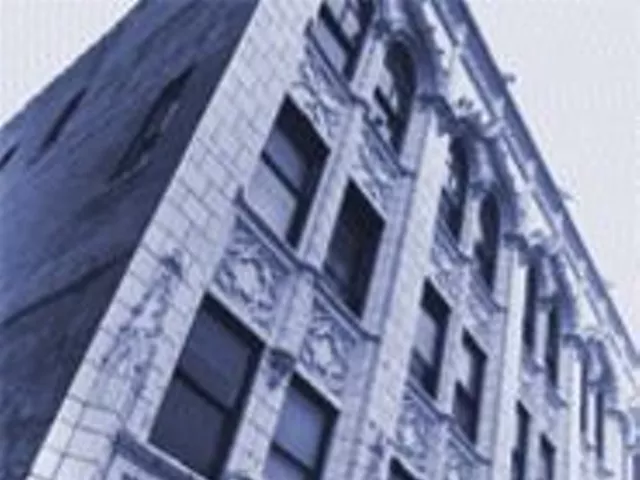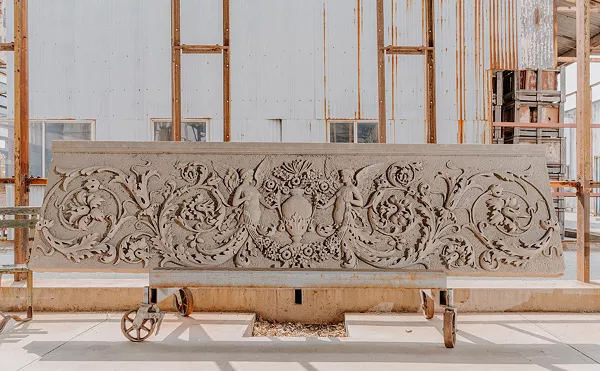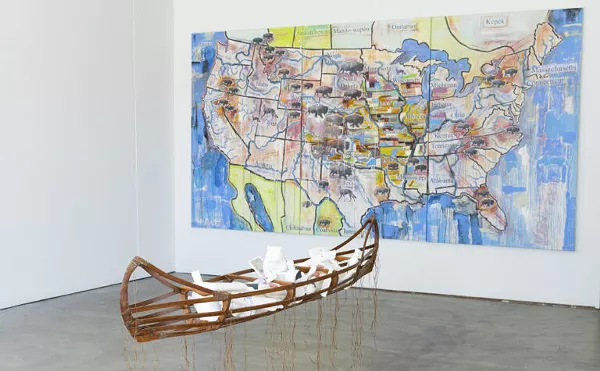The building holds within it several remarkable histories. From it, we can learn about the westward movement of St. Louis' Jewish congregations, about immigrant modern architects in America and about Eric Mendelsohn himself, a fascinating artist among architects whose masterpiece in St. Louis almost wasn't built at all. For the 50th anniversary of the dedication of the synagogue, COCA has staged an exhibition that takes viewers through each of those histories. Architect of Form and Spirit: Eric Mendelsohn in St. Louis was designed by Stephen Leet, assistant professor of architecture at Washington University. Kathleen James-Chakraborty, associate professor of architecture at the University of California at Berkeley, curated the exhibition and authored its catalog, In the Spirit of Our Age.
This kind of exhibition is risky. The curator must decide how to tell a complex story in a concise manner without losing the power of its details. How, for example, does one tell the compelling story of the B'nai Amoona synagogue, long after the building's function has been transformed? How does one tell the story of Mendelsohn without resorting to a didactic, lengthy retelling of the entire history of European modernist architecture?
Leet and James-Chakraborty have successfully answered those questions: Architect of Form and Spirit: Eric Mendelsohn is a smallish exhibition that manages to make large philosophical and historical points. It is informative, inspiring and well balanced but not overwhelming in scale. It is minimalist in style, made up mainly of text panels, photos and plans affixed to the walls (which, admittedly, won't excite anyone under the age of 15). But the exhibition also includes a well-made running video featuring vintage footage of St. Louis circa 1950 and lucid discussions of St. Louis's Jewish history and Mendelsohn's place in it. A historic-book display is one of the nicest features in the show (more on that later), and an architectural model of the building, along with a computer displaying digital photos and animated diagrams, rounds out the presentation.
The exhibition does a wonderful job of placing the B'nai Amoona building within the framework of urban and architectural history. In 1942, the conservative congregation of B'nai Amoona (Children of Faith) announced plans to construct a synagogue on a newly acquired corner lot west of St. Louis. B'nai Amoona's westward movement followed a set pattern of Jewish congregations at the time, which, since the late 19th century, had been steadily inching out to the more open, available territory beyond the city. The congregation's published announcement of its future home included a rough sketch of a synagogue, typical for its time, with a centralized, domed sanctuary.
Few could have expected that the finished building, dedicated in 1950, would look nothing like that sketch. It leaves traditional synagogue forms behind and dispenses with standard architectural ornament in favor of startlingly spare, modern lines. The design was the brainchild of Mendelsohn, who was in a singular position, when he received the commission in 1945, to apply his brand of expressive modernism to an architectural form in need of reconfiguration. Needless to say, the Jewish faith and traditions had been severely tested by World War II and the Holocaust. Mendelsohn's radical design infuses the synagogue form with a new spirit; it acknowledges the past while forging insistently forward.
After establishing the brilliance of Mendelsohn's design for the B'nai Amoona synagogue, the exhibition invites us to look back at Mendelsohn the architect and how he came to be in the position to make this startling architectural statement, which was dedicated just three years before his death in 1953.
Mendelsohn was one of the most influential modernist architects working in Germany in the 1920s. His architectural firm in Berlin played host to apprentice Richard Neutra, who would precede him in immigrating to the U.S. and in making a bold mark on American architecture. Mendelsohn chose to remain in Germany through the 1920s, working in the incredibly fertile artistic atmosphere of interwar Europe, which saw the rise of Gropius' Bauhaus, the De Stijl movement in Holland and Le Corbusier's experiments in pure, white cubic form in France.
Mendelsohn's earliest works are profoundly expressionist. His Einstein Tower in Potsdam (1919-22), an astrophysics laboratory, looks as if it has sprung full-blown from the underworld. Later commercial works absorbed the industrial aesthetic current in Europe at the time, particularly his Schocken department store in Stuttgart (1926-28), with its factory-inspired, spare horizontal lines and its dominant rounded, glazed corner (a building that, incidentally, brings to mind Louis Sullivan's Schlesinger-Meyer/Carson-Pirie-Scott department store in Chicago from 1904, but that is, perhaps, another story).
Even while in Germany, Mendelsohn was fascinated by the United States and the possibilities afforded by its urban development. In 1924, Mendelsohn traveled to the U.S. on a trip funded by a Berlin daily newspaper. He was assigned the task of analyzing the American city and published a book on his reflections. What he saw of places like New York City, Pittsburgh, Detroit and Chicago challenged his optimism about America. The book he published in 1926, America: Picturebook of an Architect, contains fascinating observations of American industrial architecture (much in the vein of Le Corbusier's Vers une architecture of 1923). But its observations of American cities are tinged with doubt about the wildness and abandon with which they appeared to have been settled.
Still, the photographs and the layout of Mendelsohn's book make it a modernist masterpiece. The COCA exhibition displays a copy of the book and makes excellent points about its influence. It contains, after all, several photographs by Fritz Lang, the influential German director who would later create the film Metropolis (1926). And the book's photographs were an influence on the Russian avant-garde artist El Lissitzky, who likened the book's layout to a dramatic film and who used at least one of its photos as the basis for his own work.
Fate would see Mendelsohn returning to the U.S. to settle permanently, but only after his 1933 emigration to England and his years spent in the British Mandate of Palestine (now Israel). Mendelsohn finally immigrated to the U.S. in 1941, settling in San Francisco and establishing his own architectural firm. Four years later, Mendelsohn had the commission for the B'nai Amoona synagogue in St. Louis.
The exhibition features Mendelsohn's preliminary sketches of the synagogue, and it's fascinating to see, in his fluid, energetic strokes, the transformation from a centralized, domed sanctuary to the unprecedented parabolic roof of the final design. Mendelsohn's building complex combines graceful, horizontal masses with the forward spring of that forceful sanctuary. One of the building's most remarkable features is its use of light. The exhibition includes a computer-animated diagram that follows the path of the light shining through the building's clerestory. Mendelsohn's design allows light to become a theme in the sanctuary, a metaphor for redemption, renewal and forward movement.
It's hard to conceive that, at one point, the building almost didn't happen. Construction of Mendelsohn's design was delayed two years while the congregation debated moving farther west. The building was finally completed at its intended location, thanks to the efforts of a handful of congregation administrators. It is to St. Louis' credit that the delay had nothing to do with the modernism of Mendelsohn's design. As the exhibition notes, St. Louis already had a long history of modernist architecture by the time Mendelsohn arrived on the scene, with buildings like the Morton D. May House (1941) in Ladue by Samuel Marx and the Shanley Building (1935) in Clayton by Harris Armstrong. Soon to come were modernist masterworks like the Famous-Barr building in Clayton (1948) and Lambert International Airport (1957), not to mention Saarinen's Gateway Arch.
The brilliance of Mendelsohn's design was not lost when the building was transformed into COCA in 1986. On the contrary, the architect's sensitivity to human scale, metaphor and open planning translate perfectly to a community arts center. The success of COCA is witness to the success of his vision.





